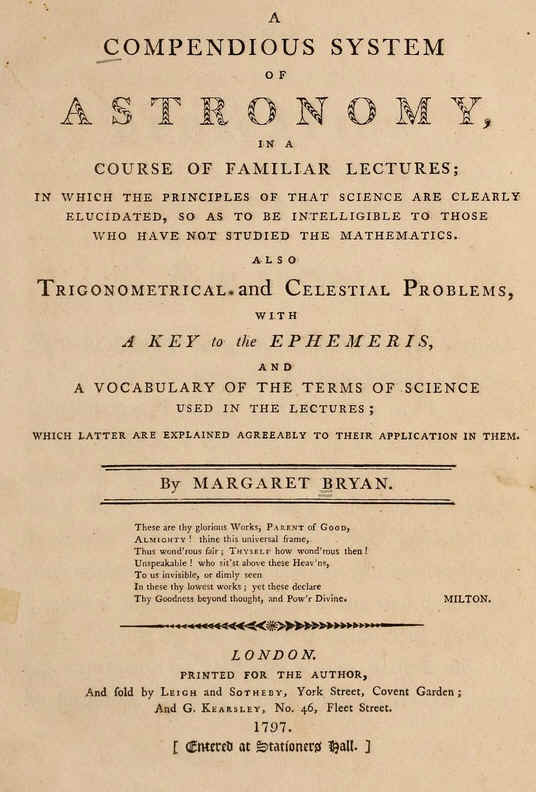
|
Margaret Bryan |
The
Northern Celestial Hemisphere, The Southern Celestial Hemisphere, in
A compendious system of astronomy, in a course of familiar lectures; in
which the principles of that science are clearly elucidated, so as to be
intelligible to those who have not studied the mathematics. Also
Trigonometrical and Celestial Problems, with a key to the ephemeris, and a
vocabulary of the terms of science used in the lectures; which latter are
explained agreeably to their application in them, |
Margaret Bryan
The Northern Celestial Hemisphere
The Southern Celestial Hemisphere
in
A compendious system of astronomy, in a course of familiar lectures; in which the principles of that science are clearly elucidated, so as to be intelligible to those who have not studied the mathematics. Also Trigonometrical and Celestial Problems, with a key to the ephemeris, and a vocabulary of the terms of science used in the lectures; which latter are explained agreeably to their application in them.

Le
incisioni dei due emisferi celesti, insieme ad altre quindici tavole, corredano
il testo divulgativo di M. Bryan concernente le prime nozioni di base della
scienza astronomica. Riportano la firma dell’incisore T. Conder.
Sono costruiti in proiezione stereografica polare equatoriale e misurano cm 15,7 di diametro, le costellazioni vi appaiono in visione convessa. Rappresentano il cielo stellato dei due emisferi dal polo equatoriale, posto al centro della tavola, al cerchio dell’equatore che ne rappresenta il perimetro. Il reticolo equatoriale è rappresentato dai poli, dai circoli polari, da quelli dei due tropici e dalle linee dei coluri. Il reticolo eclittico presenta invece i poli, linee di longitudine tracciate ogni 10° e circoli di latitudine ogni 10°, ed i relativi archi di eclittica di appartenenza ai due singoli emisferi. Mancano le scale graduate. Le stelle sono differenziate in sei ordini di magnitudine ma la relativa scala non è riportata, soltanto per alcune di quelle più luminose troviamo scritto il nome proprio.


Pleiades, Aldebaran, Hyages Castor e Pollux
Nell’emisfero boreale sono disegnate anche le costellazioni non tolemaiche di Coma Berenice, Antinous, Camelopardalus, Musca, Trigon Minor, Caput Medusae, Monoceros, Cor Caroli, Mons Menelaus, Cerberus, Anser, Asterion e Chara, Lacerta, Leo Minor, Lynx, in buona parte disegnate non a tratto continuo ma con linee punteggiate.


Trigon Minor, Caput Medusae, Musca Cor Caroli, Asterion e Chara, Coma Berenice
Nel cielo australe sono invece aggiunte le 12 costellazioni introdotte da Bayer nel 1603 nella sua Uranometria in seguito alle osservazioni effettuate nell’Oceano Indiano alla fine del cinquecento dai navigatori Keiser e Houtman, inoltre Crosiers, Robur Carolinum, Columba Noachi, parte di Sextans, Monoceros, Antinous ed il disegno di Scutum.



Polus Ecliptic Robur Carolinum Columba Noachi
Il
volume di M. Bryan può essere letto in Internet
Archive alla seguente pagina:
https://archive.org/details/compendioussyste00brya
The Northern Celestial Hemisphere


The Southern Celestial Hemisphere


Le altre tavole















di FELICE STOPPA
FEBBRAIO 2015
